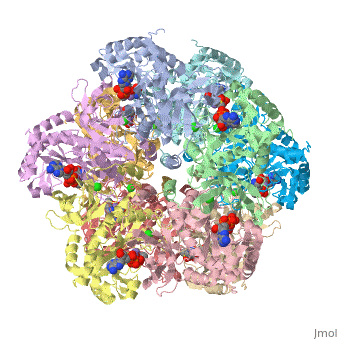User:Grace Natalie
From Proteopedia
| Line 31: | Line 31: | ||
<br> | <br> | ||
<font size=3>ATP binds at the top of the active site cavity and the glutamate binds at the bottom, | <font size=3>ATP binds at the top of the active site cavity and the glutamate binds at the bottom, | ||
| - | adjacent to the n1 ion<font size=1 face ="Arial">(Liaw 1994)</font>. The movement of Arg 359 toward | + | adjacent to the n1 ion <font size=1 face ="Arial">(Liaw 1994)</font>. The movement of Arg 359 toward the |
| - | the glutamate site, induced by ATP binding, increases the binding affinity of glutamate. The active | + | glutamate site, induced by ATP binding, increases the binding affinity of glutamate. The active site |
| - | + | of GS is located at the subunit interface (which contains n1 & n2) and is constituted mainly by the C domain | |
| - | + | of one subunit<font size=1 face ="Arial">(Liaw 1995)</font>. | |
<B>(insert wiki below that maps the ATP binding)</B></font> | <B>(insert wiki below that maps the ATP binding)</B></font> | ||
<br><br> | <br><br> | ||
Revision as of 09:56, 7 December 2008
Goals
- To map the ATP binding site
- Indicate which residues stabilize ATP binding
- Indicate which residues are important for activity and how they contribute to catalysis
Background
Glutamine synthetase (GS) catalyzes the ATP-dependent condensation of ammonia and
glutamate to yield glutamine, ADP, and inorganic phosphate in the presence of divalent cations.
The reaction occurs in two steps with γ-glutamyl phosphate as an intermediate and is used by
bacteria to introduce reduced nitrogen into cellular metabolism. GS is an enzyme of 12 identical
subunits, arranged in two rings of 6, with the active site between each pair of subunits in a ring.
GS contains two divalent cation sites (n1,n2) and one monovalent cation site per subunit.
Overall Mechanism
ATP first binds to GS, then glutamate binds and attacks ATP to form
γ-glutamyl phosphate and ADP. An ammounium ion binds to GS and then loses aproton to form the more
active species ammonia, which attacks the γ-glutamyl phosphate to yield glutamine.
ATP binding site
ATP binds at the top of the active site cavity and the glutamate binds at the bottom,
adjacent to the n1 ion (Liaw 1994). The movement of Arg 359 toward the
glutamate site, induced by ATP binding, increases the binding affinity of glutamate. The active site
of GS is located at the subunit interface (which contains n1 & n2) and is constituted mainly by the C domain
of one subunit(Liaw 1995).
(insert wiki below that maps the ATP binding)
Involving Residues
Most residues involved in enzymatic catalysis are located at the C domain but Asp50 is
contributed from the N domain of the other subunit. The binding of ADP induces Asp50’ in order to
enhance the ammonium binding, and then to deprotonate the ammonium ion to form the active ammonia
to attack the gamma-glutamyl phosphate.
| Residue | Role in enzymatic mechanism |
| Arg-321 | Coordinates the carboxylate of glutamate |
| Glu-327 | Closes active site and shields intermediate from hydrolysis |
| His-269 | Coordinates the n2 ion |
| Glu-220 | Coordinates the n1 ion |
| Asp-50 | Increases the affinity for ammonium binding |
University of Maryland Baltimore County - BioChemistry
|

